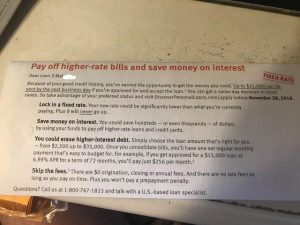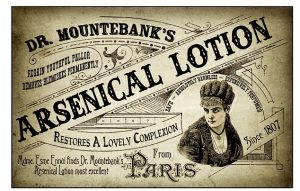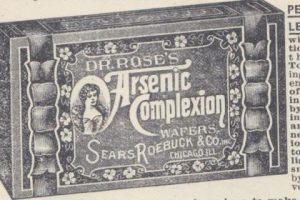LATE FEES.
 Late fees on credit cards are a major source of revenue for banks and credit card companies. Some banks make more money on late fees than interest. How can that be? If you make a late payment on a credit card, you will typically find a charge of $25 to $35 on your next monthly statement, but that isn’t where banks rake in the dough on late fees. If you make a late payment on a credit card – just one – the interest rate on your unpaid balance may automatically skyrocket. That’s particularly common on low interest rate credit cards. If you make a late payment on one of these credit cards, the interest rate on your balance may automatically go from 0% interest to 30% a year! Yes, that’s legal and, as I said, it is a very common practice. You agreed to that in the fine print of the terms and conditions of the credit card offer, the fine print that nobody reads. Plus, there are other negative consequences to having a late fee charged against you. The late fee will likely show up on your credit report because banks report late fees to the credit rating agencies. That can lower your credit score, which can lead to other negative consequences.
Late fees on credit cards are a major source of revenue for banks and credit card companies. Some banks make more money on late fees than interest. How can that be? If you make a late payment on a credit card, you will typically find a charge of $25 to $35 on your next monthly statement, but that isn’t where banks rake in the dough on late fees. If you make a late payment on a credit card – just one – the interest rate on your unpaid balance may automatically skyrocket. That’s particularly common on low interest rate credit cards. If you make a late payment on one of these credit cards, the interest rate on your balance may automatically go from 0% interest to 30% a year! Yes, that’s legal and, as I said, it is a very common practice. You agreed to that in the fine print of the terms and conditions of the credit card offer, the fine print that nobody reads. Plus, there are other negative consequences to having a late fee charged against you. The late fee will likely show up on your credit report because banks report late fees to the credit rating agencies. That can lower your credit score, which can lead to other negative consequences.WHAT SHOULD WE CALL AMERICAN INDIANS?
 William Tecumseh Sherman. William Tecumseh Sherman was the nastiest of all the U.S. generals at war with American Indians. He was the person principally responsible for forcing the Indians off the Great Plains and onto reservations. He did this by making total war on Indians, not just on one tribe or another, but all of them. It made absolutely no difference to Sherman whether a tribe was friendly or hostile or whether they had a treaty or not. Sherman’s principle method of forcing Indians onto reservations was starvation. He learned this tactic in the Civil War, where he used it to great effect against the Confederacy. Sherman’s army shot all the American bison they could find, very nearly bringing the species to extinction. This was very popular with White settlers in the West. Killing off the bison got both the bison and the Indians off the land that they wanted for themselves. With their food supply gone, the Indians had no choice but to go onto reservations. Sherman was brutally candid and shameless about what he was doing. When Sherman was called to testify to a Congressional committee, he was asked by a Senator how he defined the term ‘Indian reservation.’ Sherman said: “An Indian reservation is a completely worthless piece of land, completely surrounded by White men, all of whom are thieves.” He wasn’t laughing when he said it. What has always struck me as particularly ironic about Sherman is that he was named after a famous Indian orator and peacemaker, Chief Tecumseh.
William Tecumseh Sherman. William Tecumseh Sherman was the nastiest of all the U.S. generals at war with American Indians. He was the person principally responsible for forcing the Indians off the Great Plains and onto reservations. He did this by making total war on Indians, not just on one tribe or another, but all of them. It made absolutely no difference to Sherman whether a tribe was friendly or hostile or whether they had a treaty or not. Sherman’s principle method of forcing Indians onto reservations was starvation. He learned this tactic in the Civil War, where he used it to great effect against the Confederacy. Sherman’s army shot all the American bison they could find, very nearly bringing the species to extinction. This was very popular with White settlers in the West. Killing off the bison got both the bison and the Indians off the land that they wanted for themselves. With their food supply gone, the Indians had no choice but to go onto reservations. Sherman was brutally candid and shameless about what he was doing. When Sherman was called to testify to a Congressional committee, he was asked by a Senator how he defined the term ‘Indian reservation.’ Sherman said: “An Indian reservation is a completely worthless piece of land, completely surrounded by White men, all of whom are thieves.” He wasn’t laughing when he said it. What has always struck me as particularly ironic about Sherman is that he was named after a famous Indian orator and peacemaker, Chief Tecumseh.DOES PRESSURE TREATED WOOD CONTAIN ARSENIC?
 People have known since ancient times that arsenic is highly toxic. Nevertheless, at the turn of the 20th Century, arsenic could be found in hundreds of household products. Arsenic was commonly used as a dye to make clothing and paint bright green. Many people died as a result of that. Women who wore green dresses in the 19th Century often became sick and died from the arsenic in their clothing. Weavers and dyers also became sick and died from handling thread all day long that was soaked in arsenic. Napoleon Bonaparte died of arsenic poisoning. That has been known for a long time, but until recently, no one knew where the arsenic came from. A lot of people suspected that his English jailers put arsenic in his food, but that isn’t what happened. When Napoleon was living in exile on the island of St. Helena, his friends in France had his bedroom wallpapered to make the room look more cheerful. That house still stands. The wallpaper in Napoleon’s bedroom was recently tested and found to be loaded with arsenic. It is now believed that the arsenic in Napoleon’s wallpaper gasified in the warm humid climate of St. Helena and killed him. A lot of people in Europe and America died that same way in the 19th Century. A lot of cosmetics sold in early 20th Century also contained arsenic, like arsenic face cream, which was sold everywhere. Smearing a blemish on your face with arsenic cream will actually make the blemish go away – but at a price.
People have known since ancient times that arsenic is highly toxic. Nevertheless, at the turn of the 20th Century, arsenic could be found in hundreds of household products. Arsenic was commonly used as a dye to make clothing and paint bright green. Many people died as a result of that. Women who wore green dresses in the 19th Century often became sick and died from the arsenic in their clothing. Weavers and dyers also became sick and died from handling thread all day long that was soaked in arsenic. Napoleon Bonaparte died of arsenic poisoning. That has been known for a long time, but until recently, no one knew where the arsenic came from. A lot of people suspected that his English jailers put arsenic in his food, but that isn’t what happened. When Napoleon was living in exile on the island of St. Helena, his friends in France had his bedroom wallpapered to make the room look more cheerful. That house still stands. The wallpaper in Napoleon’s bedroom was recently tested and found to be loaded with arsenic. It is now believed that the arsenic in Napoleon’s wallpaper gasified in the warm humid climate of St. Helena and killed him. A lot of people in Europe and America died that same way in the 19th Century. A lot of cosmetics sold in early 20th Century also contained arsenic, like arsenic face cream, which was sold everywhere. Smearing a blemish on your face with arsenic cream will actually make the blemish go away – but at a price.  Arsenic face cream will eventually kill you. Cosmetic companies also sold arsenic wafers, arsenic pills, arsenic shampoo, arsenic hair tonic, and arsenic soap. When Teddy Roosevelt created the FDA (Food and Drug Administration) in 1906, one of the first things they did was ban arsenic, mercury, and lead in cosmetics. As a result, many cosmetic companies went bankrupt. Today, there are still some consumer products on the market that contain arsenic. The FDA is still debating whether to ban arsenic from commercial chicken and turkey feed, where it is still in common use.
Arsenic face cream will eventually kill you. Cosmetic companies also sold arsenic wafers, arsenic pills, arsenic shampoo, arsenic hair tonic, and arsenic soap. When Teddy Roosevelt created the FDA (Food and Drug Administration) in 1906, one of the first things they did was ban arsenic, mercury, and lead in cosmetics. As a result, many cosmetic companies went bankrupt. Today, there are still some consumer products on the market that contain arsenic. The FDA is still debating whether to ban arsenic from commercial chicken and turkey feed, where it is still in common use.LINCOLN’S GETTYSBURG ADDRESS.
I DON’T GET GOAT YOGA.
 Goat yoga is popping up everywhere. There are goat yoga studios all over the country now. There are several of them around the bay, including one in Berkeley. I do not understand goat yoga. What is the appeal of doing yoga exercises with a goat standing on your back? I don’t understand what the goats do or what benefit anyone receives from this. I heard about goat yoga just a couple of months ago at a magic convention in Las Vegas. When I first heard about it, I thought the guy who was telling me about goat yoga was pulling my leg, but he told me to check it out on Google, which I did, and I was amazed to discover that he was telling the truth. I looked at photos on Google of people doing yoga exercises with goats standing on them. I said to this guy: “I notice that the goats in these Google photos are not wearing diapers. Are these goats housebroken?” (You know what I mean.) He said: “I don’t know. That’s an interesting question.” Yes, that is an interesting question. If you are going to be doing yoga exercises with a goat standing on your back, it would be nice to know if the goat is toilet trained. But besides that, what do these goats do besides stand on your back – or your stomach? What is the point of this? As I said, I don’t get goat yoga. I’m not being coy. I really don’t get it. Don’t misunderstand me – I like goats. I petted a goat just recently at the Oakland Zoo. So did my sister. However, I had no desire for the goat to stand on my back, and as I recall, my sister didn’t express any desire for a goat to stand on her either. Can somebody explain to me what is the appeal of goat yoga? I don’t get it.
Goat yoga is popping up everywhere. There are goat yoga studios all over the country now. There are several of them around the bay, including one in Berkeley. I do not understand goat yoga. What is the appeal of doing yoga exercises with a goat standing on your back? I don’t understand what the goats do or what benefit anyone receives from this. I heard about goat yoga just a couple of months ago at a magic convention in Las Vegas. When I first heard about it, I thought the guy who was telling me about goat yoga was pulling my leg, but he told me to check it out on Google, which I did, and I was amazed to discover that he was telling the truth. I looked at photos on Google of people doing yoga exercises with goats standing on them. I said to this guy: “I notice that the goats in these Google photos are not wearing diapers. Are these goats housebroken?” (You know what I mean.) He said: “I don’t know. That’s an interesting question.” Yes, that is an interesting question. If you are going to be doing yoga exercises with a goat standing on your back, it would be nice to know if the goat is toilet trained. But besides that, what do these goats do besides stand on your back – or your stomach? What is the point of this? As I said, I don’t get goat yoga. I’m not being coy. I really don’t get it. Don’t misunderstand me – I like goats. I petted a goat just recently at the Oakland Zoo. So did my sister. However, I had no desire for the goat to stand on my back, and as I recall, my sister didn’t express any desire for a goat to stand on her either. Can somebody explain to me what is the appeal of goat yoga? I don’t get it. Update: BEER YOGA. I just got an Eventbrite invitation to go to a ‘Beer Yoga Session’ in San Francisco. See picture below. I just checked this out on Google. Beer yoga is now a real thing. There are dozens of beer yoga studios in the U.S. and Europe. This sounds almost as bizarre as goat yoga. Is anybody doing chocolate yoga?
Update: BEER YOGA. I just got an Eventbrite invitation to go to a ‘Beer Yoga Session’ in San Francisco. See picture below. I just checked this out on Google. Beer yoga is now a real thing. There are dozens of beer yoga studios in the U.S. and Europe. This sounds almost as bizarre as goat yoga. Is anybody doing chocolate yoga?NEW GRADUATE STUDENT HOUSING COMES TO MY NEIGHBORHOOD.
The apartment house at 2711 Shattuck Avenue is nearing completion and will be ready for occupancy soon. The entire building has been rented to the university, which will sublease individual units to individual graduate students. The apartments are all 310 square feet, which is very small. These apartments were built in China and arrived at the Port of Oakland in standard 8′ x 40′ shipping containers. The apartments came fully furnished and ready to move in. Each studio apartment will rent for $2180 a month and are all single occupancy (one student per apartment). This apartment house has no amenities aside from a coin-operated laundry room on each floor. There is no lobby, no yard, and no elevator. That means that if you live on the 4th floor of this building and have 4 or 5 bags of groceries, you have to shlep them up 4 flights of stairs as best you can. There is only one parking space (that’s not one parking space per unit. It’s one parking space for the whole building.) Pre-fab apartments from China are popping up in San Francisco and more are planned for Berkeley. Try to imagine what it would be like to live in an apartment that is only 8 feet wide.
WORLD WAR II WORDS & EXPRESSIONS.
Big wars always add new words to our language. All the words and terms below were invented during World War 2. During the war, every American soldier knew the meanings of all the words below. How many of them do you know?
AWOL. Acronym for Away Without Official Leave. A soldier who left his base without permission was AWOL. After a certain amount of time, he became a deserter.
Bite the Dust. Killed or wounded.
Blitzkrieg. Most people assume that the Germans invented the word Blitzkrieg, but they didn’t. The English invented this word from 2 German words: blitz (lightning) and krieg (war). Eventually, the Germans started using the word themselves.
Blockbuster. A very large bomb, usually weighing 2 tons or more, and capable of destroying or ‘busting’ an entire city block.
Brass. Officers. American officers in World War II wore brass insignias of rank.
Cash & Carry. Under Cash & Carry, a belligerent nation could buy weapons in the U.S. if they paid cash and picked them up here. England could buy tanks made in the U.S. and drive them across the Canadian border, a few miles away. Franklin Roosevelt invented the term Cash and Carry.
Chow Hound. A man who always winds up at the head of the mess line.
Dear John Letter. A letter from a wife or sweetheart saying that their relationship is over.
Duck Soup. An easy job or assignment.
Eisenhower Jacket. A short fitted belted jacket popularized by General Dwight D. Eisenhower during the war. (The blue zippered jacket that I wear is an Eisenhower jacket.)
Flat Top. An aircraft carrier.
Flying Blind. A date with a girl who you have never seen.
Get Cracking. To get something started. The term was created by RAF pilots.
G.I. An American soldier, an abbreviation for Government Issue.
Gremlins. Imaginary creatures that sabotage airplanes. The word was invented by British pilots. Any mechanical problem with an airplane was blamed on gremlins.
Haywire. An operation that went wrong or machinery that doesn’t work as it should.
Jeep. You know what a Jeep is. We don’t know who was the first person to call this vehicle a Jeep.
Joe or A Cup of Joe. Coffee. During World War 1, American soldiers called it ‘A cup of Java.’
Kamikaze. A military suicide mission.
Margarine. Imitation butter. Originally called oleomargarine.
Milk Run. An uneventful and easy bombing mission.
Molotov Cocktail. A gasoline bomb. Named after Vyacheslav Molotov, Stalin’s Foreign Minister. He encouraged Russian partisans behind German lines to make their own improvised weapons.
Pineapple. A hand grenade. American hand grenades during World War 2 were shaped somewhat like pineapples.
Pinup. A picture or poster attached to a wall of a sex symbol. The famous picture of Betty Grable, looking backwards with her hands on her hips, was the first and most famous pinup picture of the war. The word ‘pinup’ was coined by Yank magazine.
Quisling. A traitor. Named after Vidkum Quisling, a Norwegian politician who assisted the Germans in the invasion and occupation of his country.
Radar and Sonar. Radar is an acronym for Radio Assisted Detection And Ranging. Sonar stands for Sound Navigation Ranging. Radar and sonar were among the most important inventions of World War II.
Roger. Meaning ‘Message received and understood.’
Sad Sack. A sad sack is a pitiable or luckless person. This was another of the many terms coined by Yank magazine.
Section 8. A soldier sent to a psychiatric hospital or discharged from the military on grounds of insanity.
Snafu. An acronym for “Situation normal, all fouled up.” Popularized by the Private Snafu cartoons made by Warner Brothers for the U.S. Army as a training aid for soldiers.
Stinkeroo. Something of very poor quality, often used to describe bad movies.
Take Home Pay. Take home pay is what is left of your wages after tax withholding and other deductions. Income tax withholding began during World War II.
Mark’s Job Hunting Tip #3: Don’t Get a Conspicuous Tattoo.
20 years ago, it was unusual to see a student at U.C. Berkeley with a tattoo. Back then, there was only 1 tattoo parlor in the city of Berkeley. Today, there are 8 tattoo parlors in Berkeley. Lots of Cal students now have tattoos. Tattooing has become far more socially acceptable than it used to be. One quarter of all Americans between the ages of 18 and 50 have a tattoo. But wait! Before you get a Chinese dragon tattooed on your wrist or your name in Hebrew tattooed on the back of your neck, have you considered how a tattoo might affect your ability to get a job or a promotion?
A recent national survey of parents of teenagers and college students found that 68% of parents didn’t want their kids to get tattoos. The Number 1 reason parents gave was their concern that having a tattoo might hurt their kid’s chances of getting a job. Those parents have good reason to worry about that. Careerbuilder.com, a job search web site, asked HR (human resource) managers what they considered the #1 physical attribute that would most likely limit a candidate’s chances of getting a job or getting promoted. 37% said body piercings and 31% said tattoos. A similar survey conducted by philly.com put tattoos at #1. According to The Patient’s Guide, when people having tattoos removed by laser surgery were asked why they were having their tattoos removed, 50% of respondents cited ’employment’ as the principle reason. A lot of employers have dress codes and refuse to hire people with visible tattoos or piercings. Yes, that is legal. People with tattoos are not a protected class under labor or discrimination laws. If you are going to get a tattoo, my advice is to have it put someplace where it can’t be seen when you are wearing work clothes. Your friends may tell you that employers no longer care about tattoos, but that isn’t true. Some employers don’t care about tattoos, but some do.
FREE WI-FI AT AIRPORTS.
 I remember that commercial because it seemed so inappropriate. ‘Non-Stop’ is a movie about a terrorist and an alcoholic air marshal who shoot it out on an airplane while the plane is in flight. I seem to recall that there was also a suitcase full of cocaine on the airplane and a plot to kill the passengers one at a time. I thought that was a very poor choice for a commercial that people had to watch at an airport while waiting for their flights to take off. I remember thinking: “Didn’t the thought occur to somebody that this is a really bad movie to be advertising at an airport?”
I remember that commercial because it seemed so inappropriate. ‘Non-Stop’ is a movie about a terrorist and an alcoholic air marshal who shoot it out on an airplane while the plane is in flight. I seem to recall that there was also a suitcase full of cocaine on the airplane and a plot to kill the passengers one at a time. I thought that was a very poor choice for a commercial that people had to watch at an airport while waiting for their flights to take off. I remember thinking: “Didn’t the thought occur to somebody that this is a really bad movie to be advertising at an airport?”